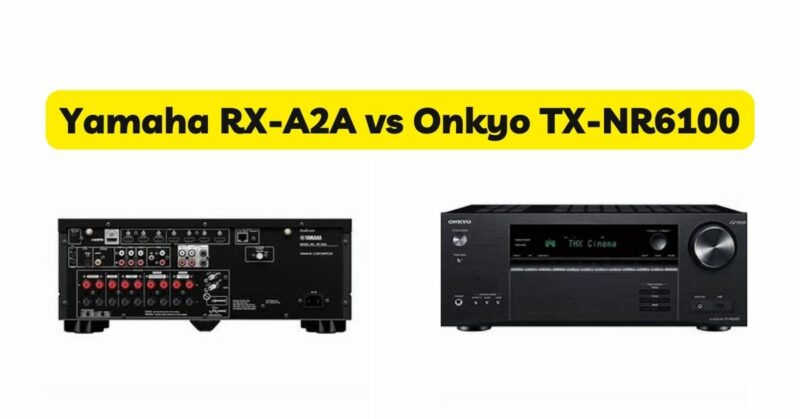Selecting the right AV receiver is crucial for achieving an immersive and high-quality audio experience in your home theater setup. In this article, we will compare two popular AV receivers: the Yamaha RX-A2A and the Onkyo TX-NR6100. These receivers from Yamaha and Onkyo respectively offer advanced features, versatile connectivity options, and exceptional audio performance. By examining their specifications, features, and performance, we aim to assist you in making an informed decision when choosing the ideal AV receiver for your entertainment system.
Yamaha RX-A2A :
The Yamaha RX-A2A is a high-performance AV receiver that combines cutting-edge features with impressive audio quality. With its 7.2-channel configuration, the RX-A2A supports immersive audio formats like Dolby Atmos and DTS:X, delivering a captivating and lifelike sound experience.
The RX-A2A incorporates Yamaha’s renowned audio engineering, including their proprietary Cinema DSP 3D technology, which optimizes the audio signals to create a natural and expansive soundstage. It also features YPAO (Yamaha Parametric Acoustic Optimizer) room calibration, ensuring accurate sound reproduction tailored to your specific room environment.
Connectivity options on the RX-A2A are comprehensive, with multiple HDMI inputs and outputs, including one HDMI input on the front panel for easy access. The receiver supports 4K Ultra HD video, HDR10+, and HDCP 2.3, guaranteeing compatibility with the latest video standards. It also features eARC (Enhanced Audio Return Channel) support, enabling high-quality audio transmission from compatible TVs.
Onkyo TX-NR6100 :
The Onkyo TX-NR6100 is a feature-packed AV receiver designed to deliver exceptional audio performance and extensive connectivity options. With its 9.2-channel configuration, the TX-NR6100 supports immersive audio formats like Dolby Atmos and DTS:X, creating a dynamic and immersive soundstage.
The TX-NR6100 incorporates Onkyo’s advanced audio technologies, including AccuEQ room calibration, which analyzes and adjusts the audio settings to ensure optimal sound quality in your specific room environment. It also features Onkyo’s VLSC (Vector Linear Shaping Circuitry) technology, which reduces digital noise and enhances the clarity of audio signals.
Connectivity options on the TX-NR6100 are comprehensive, with multiple HDMI inputs and outputs, including one HDMI input on the front panel. The receiver supports 8K Ultra HD video, HDR (High Dynamic Range), and HDCP 2.3, ensuring compatibility with the latest video standards. It also features eARC support, enabling high-quality audio transmission from compatible TVs.
Comparison and Performance :
When comparing the Yamaha RX-A2A and the Onkyo TX-NR6100, both receivers offer exceptional audio performance, support for immersive audio formats, and comprehensive connectivity options. However, there are key differences to consider.
One notable difference lies in the channel configuration. The RX-A2A offers a 7.2-channel configuration, while the TX-NR6100 provides a 9.2-channel configuration. This difference can be particularly noticeable when it comes to overhead sound effects in Dolby Atmos or DTS:X content. If you have a larger room or prefer a more expansive soundstage, the TX-NR6100’s additional channels may offer a more immersive experience.
Another distinction is the implementation of room calibration technology. The RX-A2A features Yamaha’s YPAO room calibration, which analyzes the room’s acoustics and adjusts the audio settings accordingly. In comparison, the TX-NR6100 utilizes AccuEQ room calibration, which also optimizes the audio performance based on the room’s characteristics.
In terms of connectivity, both receivers offer multiple HDMI inputs and outputs, ensuring compatibility with various devices. However, the TX-NR6100 supports 8K Ultra HD video, which provides enhanced resolution and image quality compared to the RX-A2A’s 4K Ultra HD support. If you have an 8K display or plan to upgrade in the future, the TX-NR6100 offers future-proofed connectivity.
Conclusion :
In conclusion, choosing between the Yamaha RX-A2A and the Onkyo TX-NR6100 depends on your specific requirements, budget, and preferences. The RX-A2A delivers impressive audio quality, Yamaha’s renowned audio engineering, and comprehensive connectivity options. It is a suitable choice for users seeking a high-quality AV receiver with a 7.2-channel configuration. On the other hand, the TX-NR6100 provides exceptional audio performance, extensive connectivity options, and a 9.2-channel configuration for a more immersive sound experience. Consider your room size, desired features, and compatibility with your existing equipment to select the AV receiver that best suits your needs, knowing that both models offer excellent performance and versatility.


